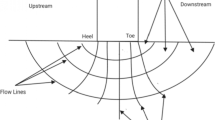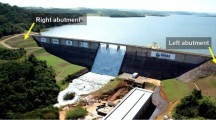Abstract
The main purpose of seepage control in dams is to prevent dams and other foundation abutments from being destroyed by seepage erosion. This control is important for safe and efficient maintenance of hydraulic and geotechnical engineering structures in the reservoir areas. Back analysis of a seepage field based on measured data is an effective way to determine the initial distribution of the seepage field, which is essential for seepage control planning and implementation of safety measures. In this paper, a back analysis method and super-equivalent continuum model were used to analyse the natural seepage field parameters and seepage field analysis in the construction zone of the dam. The results of previous analyses of the seepage field and seepage control measures provided the basic parameters and model foundation; back analysis was used to determine the boundaries of the groundwater and the calculation parameters, modify the boundary conditions of the dam foundation excavation pit, and obtain the seepage field during the construction of the hub area. The results of the back analysis show that the natural groundwater distribution simulation is generally consistent with the field data, indicating that the finite element model is an important tool for simulating the engineering geological conditions of the dam area and rock mass permeability partition.









Similar content being viewed by others
References
Ameli AA, Craig JR, Wong S (2013) Series solutions for saturated-unsaturated flow in multi-layer unconfined aquifers. Adv Water Resour 60:24–33
Angulo B, Morales T, Uriarte JA, Antiguedad I (2011) Hydraulic conductivity characterization of a karst recharge area using water injection tests and electrical resistivity logging. Eng Geol 117:90–96
Chen YF, Zhou CB, Zheng H (2008) A numerical solution to seepage problems with complex drainage systems. Comput Geotech 35:383–393
Chen SH, Xue LL, Xu GS, Shahrour I (2010) Composite element method for the seepage analysis of rock masses containing fractures and drainage holes. Int J Rock Mech Min Sci 47:762–770
He J, Chen SH (2012) A revised solution of equivalent permeability tensor for discontinuous fractures. J Hydrodyn 24(5):711–717
He J, Chen SH, Shahrour I (2011) Back analysis of equivalent permeability tensor for fractured rock masses from packer tests. Rock Mech Rock Eng 44(4):491–496
Hsieb P, Neumann SP, Simpson ES, Stiles G (1985a) Field determination of the three dimensional hydraulic conductivity tensor of anisotropic media: 1. theory. Water Resour Res 21(11):1655–1665
Hsieb P, Neumann SP, Simpson ES, Stiles G (1985b) Field determination of the three dimensional hydraulic conductivity tensor of anisotropic media: 2. methodology with application to fractured rocks. Water Resour Res 21(11):1667–1676
Hyunuk A, Yutaka I, Yasuto T, Michiharu S (2012) Comparison between iteration schemes for three-dimensional coordinate-transformed saturated-unsaturated flow model. J Hydrol 470:212–226
Lee JY, Choi YK, Kim HS, Yun ST (2005) Hydrologic characteristics of a large rockfill dam: implications for water leakage. Eng Geol (Amsterdam) 80:43–59
Li Y, Chen YF, Jiang QH, Hu R, Zhou CB (2014) Performance assessment and optimization of seepage control system: a numerical case study for Kala underground powerhouse. Comput Geotech 55:306–315
Moon JS (2011) Representativeness of jointed rock mass hydraulic conductivity obtained from packer tests for tunnel inflow rate estimate. Int J Rock Mech Min Sci 48:836–844
Nappi M, Esposito L, Piscopo V, Rega G (2005) Hydraulic characterisation of some arenaceous rocks of Molise (Southern Italy) through outcropping measurements and Lugeon tests. Eng Geol 81:54–64
Romano CG, Frind EO, Rudolph DL (1999) Significance of unsaturated flow and seepage faces in the simulation of steady-state subsurface flow. Ground Water 37:625–632
Sánchez MA, Foyo A, Tomillo C (2006) Application of the Lugeon test in landfill hydrologic studies. Environ Eng Sci 12(2):125–136
Shen ZZ, Zhao J, Wu LL (1999) A flexible tolerance method of inverting the percolation parameter. Water Resour Power 3:5–8 (in Chinese)
Shen ZZ, Jiang H, Shen CS (2009) Numerical simulation of composite geomembrane defect leakage experiment based on saturated-unsaturated seepage theory. J Hydraul Eng 40(9):1090–1095 (in Chinese)
Trottier N, Delay F, Bildstein O, Ackerer P (2014) Inversion of a dual-continuum approach to flow in a karstified limestone: insight into aquifer heterogeneity revealed by well-test interferences. J Hydrol 508:157–169
Unal B, Eren M, Yalcin MG (2007) Investigation of leakage at Ataturk dam and hydro electric power plant by means of hydrometric measurements. Eng Geol (Amsterdam) 93:45–63
Zhong DH, Zhang XX, Ao XF, Wang XL, Tong DW, Ren BY (2013) Study on coupled 3D seepage and stress fields of the complex channel project. Sci China Tech Sci 56:1906–1914
Acknowledgments
This work reported here is supported by the CRSRI Open Research Program (No. CKWV2013202/KY) and National Natural Science Foundation of China (No. 51309189) and the State Key Laboratory of Simulation and Regulation of Water Cycle in River Basin (China Institute of Water Resources and Hydropower Research) (No. IWHR-SKL-201303) and the Development of Characteristic Key Disciplines in the Local University by the Central Financial (Nos. 106-00X101, 106-5X1205) and the Program for Shaanxi Provincial Key Innovative Research Team (No. 2013KCT-015).
Author information
Authors and Affiliations
Corresponding author
Rights and permissions
About this article
Cite this article
Ren, J., Shen, Zz., Yang, J. et al. Back analysis of the 3D seepage problem and its engineering applications. Environ Earth Sci 75, 113 (2016). https://doi.org/10.1007/s12665-015-4837-1
Received:
Accepted:
Published:
DOI: https://doi.org/10.1007/s12665-015-4837-1




